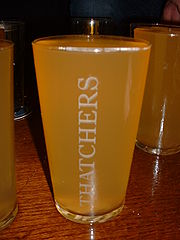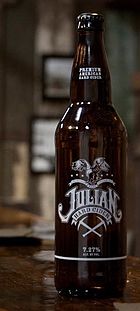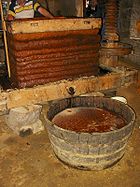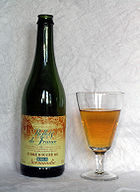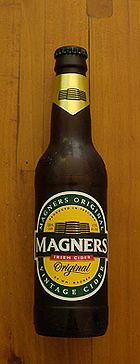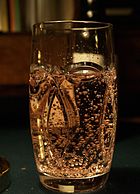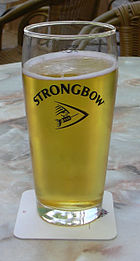
Cider
Background to the schools Wikipedia
SOS Children volunteers helped choose articles and made other curriculum material Visit the SOS Children website at http://www.soschildren.org/
Cider (pronounced /ˈsaɪdər/ SY-dər) is a fermented beverage made from apple juice. Cider varies in alcohol content from 2% ABV to 8.5% ABV or more in traditional English ciders.
Although cider can be made from any variety of apple, certain cultivars are known as cider apples. Cider is popular in the United Kingdom, especially in South West England. The United Kingdom has the highest per capita consumption of cider, as well as the largest cider-producing companies in the world, including H. P. Bulmer, the largest. As of 2006, the UK produces 600 million litres of cider each year (130 million imperial gallons).
The beverage is also popular and traditional in Ireland; in Brittany (chistr) and Normandy (cidre) in France; in Asturias, the Basque country (sagardoa) and Galicia (sidra) in Spain ; in the Rheinland-Pfalz, Hessen (Frankfurt am Main) and other regions of Germany (Most, Viez or Apfelwein). Argentina is a cider-producing and drinking country, especially the provinces of Río Negro and Mendoza. Australia produces cider, too, particularly on the island of Tasmania which has a strong apple-growing tradition.
Pear cider is becoming an increasingly popular term and is seen as an alternative name for perry. Its increased use is driven by drinks manufacturers, in order to make it more accessible and understandable to the younger generation who have been attracted to the drink in recent years.
Appearance and types of cider
The flavour of cider varies. Ciders can be classified from dry to sweet. Their appearance ranges from cloudy with sediment to completely clear, and their colour ranges from light yellow through orange to brown. The variations in clarity and colour are mostly due to filtering between pressing and fermentation. Some apple varieties will produce a clear cider without any filtration. Both sparkling and still ciders are made; the sparkling variety is the more common.
Modern, mass-produced ciders closely resemble sparkling wine in appearance. More traditional brands tend to be darker and cloudier. They are often stronger than the mass-produced varieties and taste more strongly of apples. Almost colourless "white cider" is produced on a large scale. It is typically strong (7-8% ABV) and cheap.
Cider production
Scratting and pressing
Apples grown for consumption are suitable for cider making, though some regional cider-makers prefer to use a mix of eating and cider apples (as in Kent, England), or exclusively cider apples (as in the West Country, England). There are many hundreds of varieties of cultivars developed specifically for cider making.
Once the apples are gathered from trees in orchards they are scratted (ground down) into what is called pomace or pommage. Historically this was done using pressing stones with circular troughs, or by a cider mill. Cider mills were traditionally driven by the hand, water-mill, or horse-power. In modern times they are likely to be powered by electricity. The pulp is then transferred to the cider press and built up in layers known as cheeses into a block.
Traditionally the method for squeezing the juice from the cheese involves placing sweet straw or hair cloths between the layers of pomace. This will alternate with slatted ash-wood racks, until there is a pile of ten or twelve layers. It is important to minimise the time that the pomace is exposed to air in order to keep oxidation to a minimum.
The set is then subjected to increasing degrees of pressure, until all the 'must' or juice is squeezed from the pomace. This juice, after being strained in a coarse hair-sieve, is then put into either open vats or closed casks. The pressed pulp is given to farm animals as winter feed, composted or discarded, or used to make liqueurs.
Fermentation
Fermentation is carried out at a temperature of 4–16 °C (40–60 °F). This is low for most kinds of fermentation, but is beneficial for cider as it leads to slower fermentation with less loss of delicate aromas.
Shortly before the fermentation consumes all the sugar, the liquor is racked ( siphoned) into new vats. This leaves dead yeast cells and other undesirable material at the bottom of the old vat. At this point it becomes important to exclude airborne acetic bacteria, so vats are filled completely to exclude air. The fermenting of the remaining available sugar generates a small amount of carbon dioxide that forms a protective layer, reducing air contact. This final fermentation creates a small amount of carbonation. Extra sugar may be added specifically for this purpose. Racking is sometimes repeated if the liquor remains too cloudy.
Apple based juices with cranberry also make fine ciders; and many other fruit purées or flavourings can be used, such as grape, cherry, and raspberry.
The cider is ready to drink after a three-month fermentation period, though more often it is matured in the vats for up to two or three years.
Blending and bottling
For larger-scale cider production, ciders from vats produced from different varieties of apple may be blended to accord with market taste. If the cider is to be bottled, usually some extra sugar is added for sparkle. Higher quality ciders can be made using the champagne method, but this is expensive in time and money and requires special corks, bottles, and other equipment. Some home brewers use beer bottles, which work perfectly well, and are inexpensive. This allows the cider to become naturally carbonated.
Cider festivals
A cider festival is an organized event that promotes cider and (usually) perry. A variety of ciders and perries will be available for tasting and buying. Such festivals may be organized by pubs, cider producers, or cider-promoting private organizations.
Uses of cider
Calvados and applejack are distilled from cider. Calvados is made in whole Normandy, France, and not only in the Calvados département. It is made from cider by double distillation. In the first pass, the result is a liquid containing 28–30% alcohol. In a second pass, the amount of alcohol is augmented to about 40%. Applejack is a strong alcoholic beverage made in North America by concentrating cider, either by the traditional method of freeze distillation, or by true evaporative distillation. In traditional freeze distillation, a barrel of cider is left outside during the winter. When the temperature is low enough, the water in the cider starts to freeze. If the ice is removed, the (now more concentrated) alcoholic solution is left behind in the barrel. If the process is repeated often enough, and the temperature is low enough, the alcohol concentration is raised to 30–40% alcohol by volume. In freeze distillation, methanol and fusel oil, which are natural fermentation by-products, may reach harmful concentrations. These toxins can be separated when regular heat distillation is performed. Home production of applejack is illegal in most countries.
A popular apéritif in Normandy is pommeau, a drink produced by blending unfermented apple juice and apple brandy in the barrel (the high alcoholic content of the spirit stops the fermentation process of the cider and the blend takes on the character of the aged barrel).
Cocktails may include cider. Besides kir and snakebite, an example is Black Velvet in a version of which cider may replace champagne.
A few producers in Quebec, inspired by ice wine, have developed ice cider (French: cidre de glace). For this product, the apples are frozen either before or after being harvested. Its alcohol concentration is 9–13% alcohol by volume.
Cider may also be used to make vinegar. Apple cider vinegar is noted for its high acidity and its flavour.
Related drinks
Other fruits can be used to make cider-like drinks. The most popular is perry, known in France as poiré, produced mostly in Lower Normandy, and is made from fermented pear juice. A branded sweet perry known as Babycham, marketed principally as a women's drink and sold in miniature Champagne-style bottles, was once popular but has become unfashionable. Another related drink is cyser – cider fermented with honey.
Although not widely made in modern times, various other pome fruits can produce palatable drinks. Apicius, in Book II of De re coquinaria, includes a recipe calling for quince cider.
Another similar drink is plum jerkum, made from fermented plums, traditional of Warwickshire in the English Midlands. It is said that it "left the head clear while paralysing the legs". The Warwickshire Drooper plum from which it is traditionally brewed is now uncommon, which explains the rarity of the drink.
Health
Conventional apple cider has a relatively high concentration of phenolics, namely hydroxycinnamic acid derivatives, monomeric and oligomeric flavan-3-ols, dihydrochalcones and flavonols, and antioxidants which may be helpful for preventing heart disease, cancer, and other ailments. This is, in part, because apples themselves have a fairly high concentration of phenolics.
Cider by country
Before the development of rapid long distance transportation, regions of cider consumption generally coincided with regions of cider production: that is, areas with apple orchards. For example, R. A. Fletcher notes that in the Liber Sancti Jacobi, cider was said to be more common than wine in 12th century Galicia.
Argentina
In Argentina, cider, or sidra is by far the most popular alcoholic carbonated drink during the Christmas and New Year holidays. It has traditionally been considered the choice of the middle and lower classes (along with ananá fizz, cider and pineapple juice), whereas the higher classes would rather go for champagne for their Christmas or New Year toast. Popular commercial brands of cider are Real, La Victoria, Del Valle, La Farruca and Rama Caída. It is usually marketed in 0.72 litre glass or plastic bottles.
Australia
Until recent years, virtually the only brands of cider in Australia have been Strongbow and Mercury Cider. These remain the most popular. Mercury Cider is made at the Cascade Brewery in Hobart, Tasmania. Three Oaks Cider produced in the wine making region of McLaren Vale by Vok Beverages entered the market in 2008. Pipsqueak brewed by Little Creatures in Fremantle, Western Australia is a relative new-comer in the Cider market. Even more recently, Tooheys Brewery released Tooheys Extra Dry 5 Seeds Cider. All three of these latter brands are quite large commercial entities and like Strongbow and Mercury their products are simplistic, appealing to the mass market.
Many other artisanal ciders have emerged of late. These ciders are made using traditional methods and traditional cider apple varieties. Huon Cider, made in New Norfolk, Tasmania, from Sturmer Pippin apples (an ancient variety), is available on the mainland. Henry of Harcourt and Bress cider (both from Harcourt, Victoria) are two of the most complex and interesting ciders that are commercially available. Other smaller brands rely on the available culinary fruit. From Victoria's Yarra Valley come Coldstream cider, Kelly Brothers cider and Napoleone & Co. The Bridge Road Brewery and Amulet Winery, both in Victoria's Beechworth, have released ciders. South Australia's boutique ciders include Lobo (Adelaide Hills), Thorogoods (Burra) and Aussie Cider (Barossa). WA is also entering the boutique market with several smaller makers including Elephants Rock Cider Company in Denmark named after a local tourist attraction.
There has been enormous growth in the cider market from late 2008 onwards due to a change in the laws relating to Alcohol Tax. Cider had the largest percentage growth in sales of alcohol products in 2009. With the growth in interest in cider, there have been a large number of imported ciders arriving on Australian shores, mainly from France & England, but also from Spain and New Zealand.
Austria
In Austria cider is made in the south west of Lower Austria, the so called " Mostviertel" and in Upper Austria. Almost every farmer there has some apple or pear trees. Many of the farmers also have a kind of inn called "Mostheuriger". There they serve cider and also something to eat. Cider is typically called "Most".
Belgium
Scottish & Newcastle own Belgium cider maker Stassen SA, who in addition to their own local brands such as Strassen X Cider also produce Strongbow Jacques, a 5.5% ABV cider with cherry, raspberry and blackcurrant flavours. Zonhoven based Konings NV specialises in private label ciders for European retailers and offers a wide variety of flavours and packaging options to the beverage industry.
Canada
In Quebec, cider is considered a traditional alcoholic beverage. Cider making was, however, forbidden from the early years of the British rule as it was in direct conflict with established British brewers' interests (most notably John Molson). In recent years, a unique variety has emerged on the market: ice cider. This type of cider is made from apples with a particularly high level of sugar caused by natural frost.
In Ontario, cider or apple hooch is often home-made. Cider is commercially produced in British Columbia (large and small producers), Nova Scotia, New Brunswick and Ontario, usually with a 7% alcohol content. It is sold in 341 ml glass bottles and 2 litre plastic bottles, and does not usually have added sugar.
Channel Islands
Along with Normandy, the Channel Islands had a strong cider-making tradition. Cider had been the ordinary drink of people of Jersey from the 16th century, when the commercial opportunities offered by cider exports spurred the transformation of feudal open-field agriculture to enclosure. Until the 19th century, it was the largest agricultural export with up to a quarter of the agricultural land given over to orchards. In 1839, for example, 268,199 gallons (1,219,257 litres) of cider were exported from Jersey to England alone, and almost half a million gallons were exported from Guernsey 1834–1843, but by 1870 exports from Jersey had slumped to 4,632 gallons.
Beer had replaced cider as a fashionable drink in the main export markets, and even the home markets had switched to beer as the population became more urban. Potatoes overtook cider as the most important crop in Jersey in the 1840s, and in Guernsey glasshouse tomato production grew in importance. Small-scale cider production on farms for domestic consumption, particularly by seasonal workers from Brittany and mainland Normandy, was maintained, but by the mid-20th century production dwindled until only 8 farms were producing cider for their own consumption in 1983.
The number of orchards had been reduced to such a level that the destruction of trees in the Storm of 1987 demonstrated how close the Islands had come to losing many of its traditional cider apple varieties. A concerted effort was made to identify and preserve surviving varieties and new orchards were planted. As part of diversification, farmers have moved into commercial cider production, and the cider tradition is celebrated and marketed as a heritage experience. In Jersey, a strong (above 7%) variety is currently sold in shops and a bouché style is also marketed.
In Jersey, cider is used in the preparation of black butter ( Jèrriais: nièr beurre), a traditional preserve.
Chile
Cider has been made in Chile since colonial times. Southern Chile accounts for nearly all Cider production in the country. Cider is also often linked to the production of chicha, a traditional alcoholic drink that is also made of apples but is considered of less quality.
Czech republic
Cider making has very short tradition in Czech republic. There is only one cider producer Mad Apple that has been producing cider since 2007. Cider Mad Apple is medium sweet, with 6% of alcohol, based on British type of this beverage. The Czech company makes cider from pure apple must from the Elbe plain. The origin of cider Mad Apple is in Morava, part of Czech republic where agriculture is very dominant. This region is specialized in production of wines. Cider is also imported to Czech republic, mostly from the UK. The most famous imported brands are Strongbow, Magners, Bulmers and Green Goblin.
Denmark
Despite a strong apple tradition, Denmark has little cider production. Six places that produce cider in Denmark are Pomona (since 2003), Fejø Cider (since 2003), Dancider (since 2004), Ørbæk Bryggeri (since 2006), Ciderprojektet (since 2008) and Svaneke Bryghus (since 2009). All are inspired mainly by English and French cider styles. The assortment of imported ciders has grown significantly since 2000, prior to that only ciders from Sweden, primarily non-alcoholic, were generally available. The leading cider on the Danish market is made by CULT A/S. In 2008, Carlsberg launched an alcoholic cider in Denmark called Somersby Cider.
East Asia
Cider in Japan and South Korea refers to a soft drink similar to Sprite or the UK definition of lemonade. The Chilsung Cider brand dominates the Korean market. A popular drink in mainland China is called "Apple Vinegar". It is actually cider. This drink is available in restaurants and to some degree in supermarkets. Compared to other fruit drinks and table wine, it is expensive. Shanxi Province is noted for the "vinegar" produced there.
Finland
In Finland cider holds the position as one of the most common drinks after beer. The best-known brands are Golden Cap, Fizz and Upcider. They typically contain 4,5-4,7%vol of alcohol. Virtually all Finnish cider is produced from fermented apple (or pear) juice concentrate and comes in a variety of flavours ranging from forest berries to rhubarb and vanilla.
France
French cidre is an alcoholic drink produced predominantly in Normandy and Brittany. It varies in strength from below 4% alcohol to considerably more. Cidre Doux is a sweet cider, usually up to 3% in strength. 'Demi-Sec' is 3–5% and Cidre Brut is a strong dry cider of 5% alcohol and above. Most French ciders are sparkling. Higher quality cider is sold in champagne-style bottles (cidre bouché). Many ciders are sold in corked bottles, but some screw-top bottles exist. Until the mid-20th century, cider was the second most-consumed drink in France (after wine) but an increase in the popularity of beer displaced cider's market share outside traditional cider-producing regions. In crêperies (pancakes restaurants) in Brittany, cider is generally served in traditional ceramic bowls (or wide cups) rather than glasses. A kir Breton (or kir normand) is a cocktail apéritif made with cider and cassis, rather than white wine and cassis for the traditional kir. The Domfrontais, in the Orne (Basse-Normandie), is famous for its pear cider (poiré). The calvados du Domfrontais is made of cider and poiré.
Some cider is also made in south western France, in the French part of the Basque Country. It is a traditional drink there and is making a recovery. Ciders produced here are generally of the style seen in the Spanish part of the Basque Country.
Calvados, from Normandy, is a spirit is made of cider through a process called double distillation. In the first pass, the result is a liquid containing 28%–30% alcohol. In a second pass, the amount of alcohol is augmented to about 40%.
Breton cider making employs the technique of keeving (from the French cuvée). In keeving, calcium chloride and a special enzyme are added to the pressed apple juice, causing protein in the juice to precipitate to the top for removal. This reduces the amount of protein available to the yeast, starving it and therefore causing the cider to finish fermenting while sugar is still available. The result is a sweeter drink at a lower alcohol level but still retaining the full flavour of the apples, without dilution.
Germany
German cider, usually called Apfelwein (apple wine), and regionally known as Apfelmost (apple must), Viez (from Latin vice, the second or substitute wine), or Saurer Most (sour must), has an alcohol content of 5.5%–7% and a tart, sour taste.
German cider is mainly produced and consumed in Hessen, particularly in the Frankfurt, Wetterau and Odenwald areas, in Moselfranken, Merzig ( Saarland) and the Trier area, as well as the lower Saar area and the region bordering on Luxembourg and in the area along the Neckar river in Swabia. In these regions, there are several large producers, as well as numerous small, private producers often using traditional recipes. An official Viez route or cider route connects Saarburg with the border to Luxembourg.
India
Indian cider is mainly produced in the Himachal Pradesh state in Northern India. Cider made from apple, peer, plum, peach and other fruits is produced and marketed by state run firms such as the Himachal Pradesh Fruit Marketing & Processing Corporation (HPMC) and private firms such as Green Valley (Tempest Cider).
Ireland
Cider is a popular drink in Ireland; for a long time cider production was officially encouraged and supported by a preferential tax treatment. A single cider, Bulmers, dominates sales in Ireland: Owned by C&C and produced in Clonmel, Co. Tipperary, this Bulmers has a connected history to the British Bulmers cider brand up until 1949. Outside the Republic of Ireland, C&C brand their cider as Magners. It is very popular in Ireland to drink cider over ice and encouraged in their advertising. Cidona, essentially a non-alcoholic version of Bulmers, is a popular soft drink in Ireland, and used to be a C&C-owned brand.
Italy
Cider was once widely produced in Northern Italy's apple growing regions, with a marked decline during fascist rule, due to the introduction of a law banning the industrial production of alcoholic beverages derived from fruits of less than 7% ABV, which was aimed at protecting wine producers. Present laws and regulations are favourable to cider makers, but production has only survived in a few alpine locations, mostly in the regions of Trentino, and in Piedmont, where it is known as vin ëd pom (apple wine) or pomada, because it traditionally was left to ferment in a vat along with grape pomace, giving it a distinctive reddish colour. Taxation is equal to comparable drinks and most Italians are not aware of the existence of cider, making cider an unusual and difficult to find drink in most of Italy.
Luxembourg
In Luxembourg, viez (pronounced feetz) is rather like English scrumpy. It is cloudy and varies from non-alcoholic to very alcoholic. It is made only in autumn.
Mexico
There are two types of cider (sidra) sold in Mexico. One type is a popular apple flavoured carbonated soft drink, sold under a number of soft drink brands, such as Sidral Mundet and Manzana Lift (both Coca-Cola FEMSA brands). The alcoholic sidra is a sparkling cider typically sold in champagne-style bottles with an alcohol content comparable to beer. Sidra was, due to the expense of imported champagne, sometimes used as a substitute for New Year's Eve toasts in Mexico, as it is also a sweet, fruity drink. However, now the practice is to drink cider on Christmas Eve, celebrated with the family, and champagne on New Year's, celebrated with friends. Cider beverages form a very small share of the Mexican alcoholic beverages with the figures for 2009 volume sales amounting to only 3.8 million liters.
Netherlands
In The Netherlands cider is not as commonly available as in its surrounding countries. In 2007 Heineken started testing a cider brand named Jillz in a number of bars throughout the country. The beverage (rather a cider drink beer with fruity sparkling water) is Heineken's leading cider brand, promoted towards female drinkers as an alternative to beer. At the same time, Strongbow Gold was introduced as a secondary brand to provide a measure of choice. Both contain 5% alcohol by volume, which is similar to a typical draught beer in the Netherlands. As of 2009 most supermarkets carry the two dominant brands. Other brands are available from selected retailers, most noticeably Magners and Savanna Dry.
New Zealand
In New Zealand, McCashins Brewery produces both an Apple and Pear cider commonly available at most supermarkets and bottle stores. Several other companies produce and/or distribute cider in the country. There are a number of boutique cider houses, particularly in the Hawke's Bay Region. Monteith's Brewery in Greymouth on the west coast of the south island make an apple cider of increasing international popularity, particularly with the Australian market.
Norway
In Norway, cider (sider) is a naturally fermented apple juice. Pear juice is sometimes mixed with the apple to get a better fermenting process started. The main area for cider production is in the proclaimed "fruit garden" or "apple orchard" of Norway, the Hardanger region.
Following lengthy navigation through the directives of Norway's complex alcohol laws, three brands of sparkling cider with an abv of approximately 10% are available to the Norwegian public through distribution by the monopoly outlet Vinmonopolet, Hardanger Sider Sprudlande from Hardanger, Krune Sider from Bergen sourcing apples from Hardanger, and Liersider from Lier. In line with the law of 1975 prohibiting all advertising of alcoholic beverages of abv greater than 2.5%, the products receive little exposure despite some favourable press reaction.
Ciders of low alcohol levels are widely available, mostly brands imported from Sweden, although carbonated soft drinks with no alcoholic content may also be marketed as "cider".
Pakistan
Non-alcoholic, apple-flavored carbonated drinks are popular in the country, with local brands suchs as Mehran Bottler's Apple Sidra and Murree Brewery's Bigg Apple in the market.
South Africa
There are two main brands of cider produced in South Africa, Hunters Gold and Savanna Dry. They are produced and distributed through Distell Group Limited. Hunters Gold was first introduced in South Africa in 1988 as an alternative to beer. The range includes Hunters Dry and Hunters Export. Savanna Dry was introduced in 1996 and also comes in a Light Premium variety. Clarens, Free State has a micro brewery called Clarens Brewery that produces 100% natural apple cider. The taste of real apple cider differs enormously from the mass produced variety.
Spain
The making and drinking of cider is traditional in several areas of northern Spain, mainly Asturias and the Basque Country.
Cider has been popular in the Basque Country for centuries. Known as sagardoa (IPA: /s̺a'gaɾdoa/), it is drunk either bottled or in a cider house (called a sagardotegi), where it is poured from barrels. Most of "sagardotegis" are in the north of Guipuscoa (Astigarraga, Hernani, Urnieta and Usurbil), but they can be found everywhere in Guipuzcoa, the north-west of Navarre and the Northern Basque Country.
Cider tasting events are popular in the Basque province of Gipuzkoa, where stalls are set up on the street selling the drink from several producers at cheap prices and served until stock runs out.
But the largest producer of cider in Spain is the Atlantic region of Asturias, amounting to more than the 80% of the whole production of Spain. The consumption of cider in Asturias is of 54 liters per person/year, probably the highest in any European region. The most popular cider in Spain, for example, is called "El Gaitero" (the bagpipe player) after the famous Asturian players. It is a factory produced cider, sweet and very foamy, much like lambrusco, different from the more artisan and traditional cider productions. Recently, new apple tree plantations have been started in grounds belonging to the old coal mines, once important in Asturias
The first testimony about cider in Asturies was made by Greek geographer Strabo, in the year 60 BC.
The traditional Asturian sidra, is a still cider of 4–8% strength, although there are other varieties. Traditionally, it is served in sidrerías and chigres, pubs specializing in cider although it is also possible to have other drinks as well as traditional food, where it is poured in very small quantities from a height into a wide glass, with the arm holding the bottle extended upwards and the one holding the glass extended downwards. This technique is called to escanciar un culín (also echar un culín) and is done to get air bubbles into the drink (espalmar), thus giving it a sparkling taste like Champagne that lasts a very short time.
Sweden
Due to Swedish law, stores in Sweden cannot sell cider with less than 15 percentage juice by volume under the name Cider. "Cider" with none or less than 15% juice is instead usually sold as "Apple/Pear beverage of cider character" (Swedish)"Äpple-/Pärondryck med Ciderkaraktär. Brands of cider in Sweden include Rekorderlig, Kivik and Kopparberg cider. Most Swedish cider has little in common with traditional cider from other countries. Usually it is very sweet and it is very often berry or fruit flavoured, making it more like an alcoholic fruit soda.
United Kingdom
In the UK, cider is mostly associated with the West Country, Herefordshire & Worcestershire, but is also produced in Wales and across England, particularly Kent, Suffolk and Norfolk, Cheshire is also home to two cider brewing farms . Cider is available in sweet, medium and dry varieties. Recent years have seen a significant increase in cider sales in the UK. U.K. cider and perry producers
Cider types in the United Kingdom
There are two broad main traditions in cider production in the UK - the West tradition and the Kent and East Anglia tradition. The former are made using a much higher percentage of true cider-apples and so are richer in tannins and sharper in flavour. Kent and East Anglia ciders tend to use a higher percentage of, or are exclusively made from, culinary and dessert fruit; Kentish ciders such as Biddenden's, Rough Old Wife and Theobolds are typical of this style. They tend to be clearer, more vinous and lighter in body and flavour.
At one end of the scale are the traditional, small farm-produced varieties. These are non-carbonated and usually cloudy orange in appearance. England's West Country contains many of these farms. Production is often on such a small scale the product is only sold at the point of manufacture or in local pubs and shops
At the other end of the scale are the mass production factories for products such as Strongbow and Blackthorn.
Mass produced commercial cider such as that produced by Bulmers is likely to be pasteurised and force-carbonated. The colour is likely to be golden yellow with a clear appearance from the filtration. White ciders are almost colourless in appearance.
Cheap strong ciders
A key market segment exists in the UK for strong white mass-produced cider at 7.5% alcohol by volume. Cider with higher than 7.5% alcohol has a higher rate of excise duty. Typical brands include White Lightning, Diamond White, Frosty Jack, and White Strike.
By volume of alcohol, the excise duty on cider is lower than any other drink. The duty, as of 2009, was £31.83 per 100 litres of cider of up to 7.5% alcohol. 100 litres of table wine or alcopops would attract £214.02 of duty, wine under 5.5% was charged £90.68, £123.53 for 100 litres of 7.5% beer, and £169.80 for the equivalent alcohol volume of spirits.
Before 1996 brands could be labelled at up to 8.4% alcohol when they actually contained 7.4%. This happened because the duty was levied on the actual strength of the alcohol, but Trade Descriptions legislation allowed the label to overstate the alcohol content by up to 1%. White Lightning was then sold in both 7.4% and 8.4% strengths, due to uncertainty about whether consumers would prefer the pricier, stronger drink, or the slightly weaker, cheap one.
Until 2005, the market leading White Lightning brand was being sold on an almost continual 50% extra free promotion, giving 3 litres of 7.5% cider for a typical selling price of £2.99. Scottish Courage, which owned the brand, decided that year to restrict bottle size to 2 litres as part of its responsible drinking strategy. A spokesman for the company spoke of white cider in general, "It is the cheapest way to buy alcohol in the UK. This is pocket money these days. There is no other alcohol category that has the same challenge as white cider. One three litre plastic bottle of white cider contains almost the full recommended weekly alcohol intake for a male drinker" (225 ml, 22.5 units, of pure alcohol content compared with the recommended maximum of 28 units). This led to a 70% drop in sales of White Lightning, but increased sales of the brand owner's weaker, more profitable brands. Other manufacturers followed by increasing prices and scrapping their 3 litre bottles.
The price increases on 7.5% cider has increased sales of 5% mass-market cider, which is still widely available in 3 litre bottles in supermarkets.
Since September 2010, HM Revenue and Customs has decreed that to be called cider a drink must contain at least 35% apple or pear juice and must have a pre-fermentation gravity of at least 1033 degrees. The legislation was introduced to stop cheap high alcohol content drinks being called cider, thus taking advantage of the lower duty rates applied to cider.
West of England
Cloudy, unfiltered ciders made in the West Country are often called "scrumpy", from "scrump", a local dialect term for a small or withered apple. Ciders from Gloucestershire, Herefordshire and Worcestershire made from traditional recipes have a Protected Geographical Indication awarded by the European Union. There are over 25 cider producers in Somerset alone, many of them small family businesses. Large West Country producers include Thatchers Cider in Sandford, Somerset, as well as Brothers Cider and Gaymer Cider Company, both of which are based in Shepton Mallet, Somerset. The latter has the largest cider plant in Europe, which produces a number of brands including Blackthorn and Olde English.
During the 17th and 18th centuries, a condition known as Devon colic, a form of lead poisoning, was associated with the consumption of cider, vanishing after a campaign to remove lead components from cider presses in the early 19th century.
Wales
Cider is called “seidr” in Welsh.
Smallhold production of cider made on farms as a beverage for labourers died out in Wales during the 20th century. Cider and perry production in Wales began a dramatic revival in the early 2000s, with many small firms entering production throughout the country. The Campaign for Real Ale (CAMRA) has actively encouraged this trend, and Welsh ciders and perries have won many awards at CAMRA festivals; meanwhile, the establishment of groups such as UKCider and the Welsh Perry & Cider Society have spurred communication among producers.
Welsh varieties of apples and pears are often distinct from those grown in England, giving cider from Wales a flavour noticeably different to ciders from nearby regions.
Definition of "real" cider
CAMRA defines "real" cider as a product containing at least 90% fresh apple juice, with no added flavourings or colourings. CAMRA appears to endorse chaptalisation of the juice (added sugar prior to fermentation) plus dilution with water afterwards. UKCider defines "real" cider as a product containing at least 85% fresh apple juice, with no artificial flavourings or colourings. UKCider campaigns for the percentage juice content to be listed as part of a full ingredients labelling. In contrast, UK law defines cider as containing at least 35% apple or pear juice, which may be from concentrate.
United States
During colonial times apple cider was consumed as the main beverage with meals because water was often unsafe for drinking. Ciderkin, a slightly alcoholic beverage made from cider pomace, could also be found on colonial tables.
Sometime after Prohibition the word cider came to mean unfiltered, unfermented apple juice. For instance, in Pennsylvania, apple cider is legally defined as an "amber golden, opaque, unfermented, entirely non-alcoholic juice squeezed from apples". Imitation "cider" products may contain natural or artificial flavours or colours generally recognized as safe, provided their presence is declared on the label by the use of the word "imitation" in type at least one-half the size of the type used to declare the flavour. Cider containing more than 0.5 percent alcohol by volume is classified as hard cider.
Cider may also refer to sparkling apple juice, which is often filtered, such as Martinelli's sparkling apple cider, once touted specifically as "non-alcoholic cider". Martinelli's is sold as "cider" or "juice" depending on regional usage.
Alcoholic cider is produced throughout the United States, especially in New England, Michigan, upstate New York and the West Coast. Some U.S. products which describe themselves as Hard Cider are made by adding flavourless spirit alcohol to apple juice pressed from juice apples rather than cider apples.
Smaller cider breweries are becoming more common as well, some producing varieties of hard cider reminiscent of English ciders.

